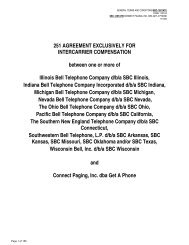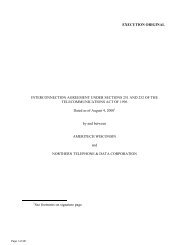Optical Telecommunications, Inc.
Optical Telecommunications, Inc.
Optical Telecommunications, Inc.
Create successful ePaper yourself
Turn your PDF publications into a flip-book with our unique Google optimized e-Paper software.
Version: 2Q05 Standard ICA<br />
07/06/05<br />
Attachment 10<br />
Page 6<br />
The nature and severity of any disaster will influence the recovery procedures. One crucial factor<br />
in determining how BellSouth will proceed with restoration is whether or not BellSouth's<br />
equipment is incapacitated. Regardless of whose equipment is out of service, BellSouth will<br />
move as quickly as possible to aid with service recovery; however, the approach that will be<br />
taken may differ depending upon the location of the problem.<br />
5.1 CLEC OUTAGE<br />
For a problem limited to one CLEC (or a building with multiple CLECs), BellSouth has several<br />
options available for restoring service quickly. For those CLECs that have agreements with other<br />
CLECs, BellSouth can immediately start directing traffic to a provisional CLEC for completion.<br />
This alternative is dependent upon BellSouth having concurrence from the affected CLECs.<br />
Whether or not the affected CLECs have requested a traffic transfer to another CLEC will not<br />
impact BellSouth's resolve to re-establish traffic to the original destination as quickly as possible.<br />
5.2 BELLSOUTH OUTAGE<br />
Because BellSouth's equipment has varying degrees of impact on the service provided to the<br />
CLECs, restoring service from damaged BellSouth equipment is different. The outage will<br />
probably impact a number of Carriers simultaneously. However, the ECC will be able to initiate<br />
immediate actions to correct the problem.<br />
A disaster involving any of BellSouth's equipment locations could impact the CLECs, some more<br />
than others. A disaster at a Central Office (CO) would only impact the delivery of traffic to and<br />
from that one location, but the incident could affect many Carriers. If the CO is a Serving Wire<br />
Center (SWC), then traffic from the entire area to those Carriers served from that switch would<br />
also be impacted. If the switch functions as an Access Tandem, or there is a tandem in the<br />
building, traffic from every CO to every CLEC could be interrupted. A disaster that destroys a<br />
facility hub could disrupt various traffic flows, even though the switching equipment may be<br />
unaffected.<br />
The NMC would be the first group to observe a problem involving BellSouth's equipment.<br />
Shortly after a disaster, the NMC will begin applying controls and finding re-routes for the<br />
completion of as much traffic as possible. These reroutes may involve delivering traffic to<br />
alternate Carriers upon receiving approval from the CLECs involved. In some cases, changes in<br />
translations will be required. If the outage is caused by the destruction of equipment, then the<br />
ECC will assume control of the restoration.<br />
5.2.1 Loss of a CO<br />
When BellSouth loses a CO, the ECC will<br />
a) Place specialists and emergency equipment on notice;<br />
b) Inventory the damage to determine what equipment and/or functions are lost;<br />
c) Move containerized emergency equipment and facility equipment to the stricken area,<br />
if necessary;<br />
d) Begin reconnecting service on a parity basis for Hospitals, Police and other emergency<br />
agencies or End Users served by BellSouth or CLEC in accordance with the TSP priority<br />
CCCS 253 of 261
















